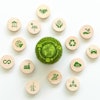
The EU-funded project REFUCOAT has successfully developed a new set of innovative and resource-efficient processes for producing bioplastics for food packaging from renewable materials, with a strong potential to replace traditional fossil-based raw materials.
Using these bioplastics, which include polyhydroxyalkanoates (PHA) and polyglycolic acid (PGA), REFUCOAT has developed three different bio-based active packaging systems, designed specifically for fresh chicken, breadcrumbs and crisps. A key innovation has been the development of coatings based on bacteriophages which significantly slow down the growth of Samonella bacteria in chicken samples packed in modified atmosphere packaging (MAP) chicken breast samples. Current plastic production relies heavily on raw materials from fossil-based, non-renewable sources and many food products require complex multilayer plastic packaging that is often difficult or expensive to recycle. All of REFUCOAT’s packaging systems are recyclable and/or compostable, making them a promising sustainable alternative to current packaging on the market.
Lorena Rodriguez Garrido, from AIMPLAS, Technical Institute of Plastics, and Scientific Coordinator of REFUCOAT, said: “Packaging needs to be recyclable, while at the same time maintaining the optimal barrier properties needed to protect the food inside. Current complex multi-layer packaging made from non-renewable sources are difficult and expensive to recycle. REFUCOAT’s goal is to replace current packaging with sustainable, high-performing alternatives.“
High-performance packaging design
Over the past three years, REFUCOAT has concentrated on three main areas:
- developing active coatings for food packaging films that increase the shelf life of the food products. These coatings contain bacteriophages which attack unwanted bacterial growth. REFUCOAT results shown a significant reduction in Salmonella growth when these coatings are used in modified atmosphere packaging (MAP) chicken breast samples.
- a food industry by-product, low quality flour that would otherwise have been wasted, was used as a source material to produce the biodegradable biopolymer PHA via microbial fermentation. This material has been used to produce active packaging trays that extend the shelf life of fresh chicken products.
- REFUCOAT has developed for the first time an efficient process for producing PGA and its precursor industrially relevant conditions. This scaled up production has the potential to reduce the cost of production of PGA which has so far been too expensive to replace current fossil-based materials. PGA is a fully biodegradable material with excellent water barrier properties, and therefore promising applications in food packaging.
Depending on the main factor that affects the shelf life of each different food (e.g. moisture, oxygen, microbes), each REFUCOAT packaging system has been carefully designed and developed. The innovative barrier and active coatings developed during the project are combined with commercial bio-polyethelyene (bio-PE), bio-polyethylene terephthalate (bio-PET) and REFUCOAT PHA and polylactic acid (PLA) to produce high-performance packaging structures for free chicken meat, breadcrumbs and crisps.



















